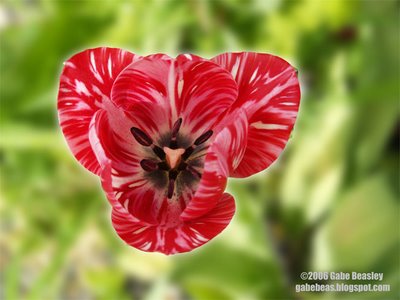
This is a Photoshop creation I did of a half sized tulip in my yard. The last of the ones to come up late--they added a new number of colors to my collection of pictures. I did this shot with a two layer cutout--you cut out the flower from it's first layer and then blank it--the blur the background--then leave a small edge of whiteness by pasting the flower back into place very carefully. I can make the background as blurred as I want it to be.
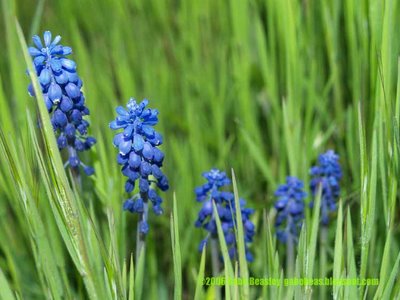
Another kind of flower I know nothing about but now have many pictures of. One of my neighbors has a ton of them--and I have not yet process several nice shots of these that include stop action honey bees. These popped up in my back yard as well.
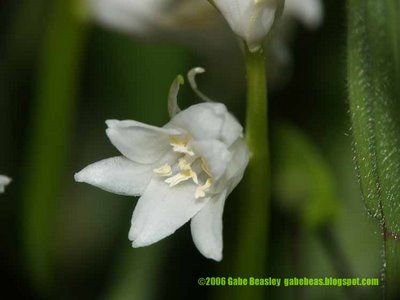 This flower is a microscopic near-match to a relatively huge flower that popped up in my yard. You would think with all these flowers compared to last year--someone had to be behind it! Last year I had the usual dandy lions--nothing more. This year I had a jackpot of flower shots that have already sold. Keep those sales coming---these shots are all done with my new camera in high-res--my price is still the same--$20 for a CD so you can "do it yourself" print and frame--or I can do the frame and matte for you--that will cost you $30 bucks plus expenses at 8x10. I have had to revise my prices. If you live outside of Oregon e-mail me for contacts about pictures. News and other agencies can get these pictures for free. E-mail me. Prints are not available nationwide. CD s are for $20 a peace.
This flower is a microscopic near-match to a relatively huge flower that popped up in my yard. You would think with all these flowers compared to last year--someone had to be behind it! Last year I had the usual dandy lions--nothing more. This year I had a jackpot of flower shots that have already sold. Keep those sales coming---these shots are all done with my new camera in high-res--my price is still the same--$20 for a CD so you can "do it yourself" print and frame--or I can do the frame and matte for you--that will cost you $30 bucks plus expenses at 8x10. I have had to revise my prices. If you live outside of Oregon e-mail me for contacts about pictures. News and other agencies can get these pictures for free. E-mail me. Prints are not available nationwide. CD s are for $20 a peace.It ends up to be about $50-60 bucks total depending on the picture. NO MATTE pictures still available by request--that's like an 8x10 family picture (see last months posts I have a whole collection of non-matte pictures layer out on my sofa) -non-matte simple frame shots go for only $20-40 a print in frame only.
ALL REQUESTS ARE POSSIBLE AND I'M WILLING TO MAKE DEALS! E-mail me!
The flower (below) looks kind of like it but is many, many times larger. The one above I don't think is a tulip--but I'm almost sure just by looks that the one below is a different looking tulip then my others. These straight from the camera shots taken at ISO400 in some cases show how well my new camera handles whites. Very well.
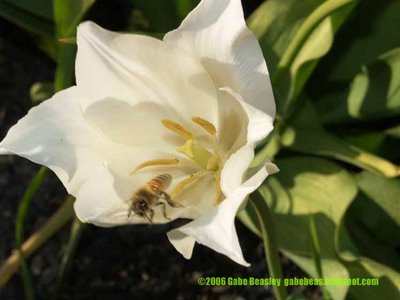 A honey bee racing out of the flower having gotten her load of pollen. This flower is several hundred times larger then the tiny flower above which is only about 3mm long. For an example--this flower is about 70-80mm wide! These flowers are of course not related very much except in looks.
A honey bee racing out of the flower having gotten her load of pollen. This flower is several hundred times larger then the tiny flower above which is only about 3mm long. For an example--this flower is about 70-80mm wide! These flowers are of course not related very much except in looks.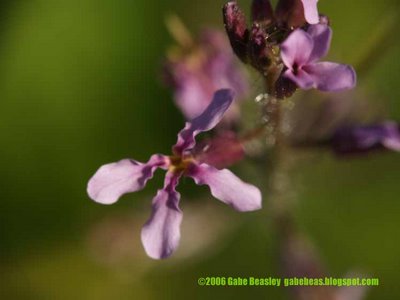 These are some of the smallest flowers I've ever photographed. It takes allot of skill and a steady hand to hold the camera very close to the ground where no-tripod can go. Then I have to focus and get it right. Sometimes better then others---I have a backlog a mile long of pictures like this---SO KEEP CHECKING for more. Tell me what you want to see!
These are some of the smallest flowers I've ever photographed. It takes allot of skill and a steady hand to hold the camera very close to the ground where no-tripod can go. Then I have to focus and get it right. Sometimes better then others---I have a backlog a mile long of pictures like this---SO KEEP CHECKING for more. Tell me what you want to see!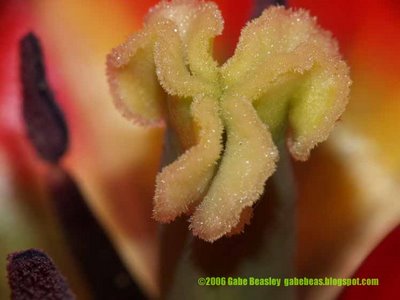 This is the inside of the business end of a tulip. If I recall my biology this flower is both male and female. It has this middle Oregon (don't ask me how to spell it) and the row of male organs around it. It will usually pollinate itself, but for bio-diversity every now and then a bee flies in with pollen from another flower--causing changes and a new kind of flower. The process of color changes and other things thus continues. Most people don’t realize why flowers look like they do. One word and one word only--INSECTS. Every flower on Earth is colored to be pretty to be viewed by Insects for cross pollination permitting more genetic diversity. If it were not for insects no flowers would look anything worth looking at. The patterns we see are only half of what insects can see in the UV spectrum--which reveals an incredible number of more features to many flowers. I don’t have a UV camera but 120 film might be available for that. I’m not sure. Flowers got beautiful to guide insects in and out just like an aircraft carrier with planes. It’s an operation of fuel for pollen. Mutual benefits. One species or orchid has science stuck a bit--how did this orchid evolve to be just the right size and shape and color to look just like a female wasp--not to mention most of all--smell like one ready to mate. The wasp actually mates with the flower and thus catches a pollen packet which it passes to the next flower it mates with. This incredible system is a paradox in a way. Kind of like that one about the chicken before the egg. Which one came up first?
This is the inside of the business end of a tulip. If I recall my biology this flower is both male and female. It has this middle Oregon (don't ask me how to spell it) and the row of male organs around it. It will usually pollinate itself, but for bio-diversity every now and then a bee flies in with pollen from another flower--causing changes and a new kind of flower. The process of color changes and other things thus continues. Most people don’t realize why flowers look like they do. One word and one word only--INSECTS. Every flower on Earth is colored to be pretty to be viewed by Insects for cross pollination permitting more genetic diversity. If it were not for insects no flowers would look anything worth looking at. The patterns we see are only half of what insects can see in the UV spectrum--which reveals an incredible number of more features to many flowers. I don’t have a UV camera but 120 film might be available for that. I’m not sure. Flowers got beautiful to guide insects in and out just like an aircraft carrier with planes. It’s an operation of fuel for pollen. Mutual benefits. One species or orchid has science stuck a bit--how did this orchid evolve to be just the right size and shape and color to look just like a female wasp--not to mention most of all--smell like one ready to mate. The wasp actually mates with the flower and thus catches a pollen packet which it passes to the next flower it mates with. This incredible system is a paradox in a way. Kind of like that one about the chicken before the egg. Which one came up first?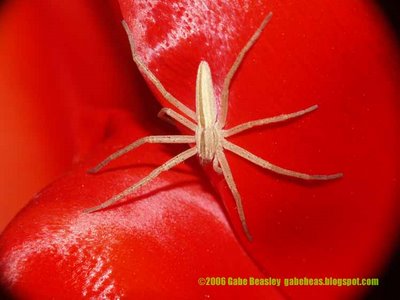 I REALLY like these spiders. This is a "true" grass spider. They are not very common and spend most of there time in very hard to find places. I was shooting 35mill when I found this one. It was just sitting on one of my tulips--I have close-up shots of it as well as more comprehensive showing the whole flower. Once again I ask you--make a request if you want.
I REALLY like these spiders. This is a "true" grass spider. They are not very common and spend most of there time in very hard to find places. I was shooting 35mill when I found this one. It was just sitting on one of my tulips--I have close-up shots of it as well as more comprehensive showing the whole flower. Once again I ask you--make a request if you want.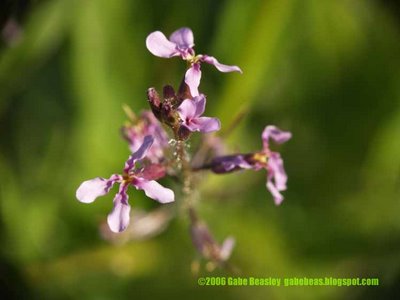
Another shot of tiny flowers. They are so small my macro lens has a hard time with the depth of field even at f22. I have more pictures to come of these kinds of flowers that you will want to see if you like this stuff--I need to get them converted for the internet first. This is allot of work. It can take me an average of four hours to do a post five to ten pictures long.
 Now this is the fun part--here is the flower--and (below) the bettle that crawled in it to look for nector. This beelte is allmost impossible to see very well without a macro lens or magnifine glass. I first found many months ago and photographed it next to a quarter--these little beetles are so small that a thousand of them could fit in this flower. You can get some idea of how bit it is by the picture below and the flower it is inside (above).
Now this is the fun part--here is the flower--and (below) the bettle that crawled in it to look for nector. This beelte is allmost impossible to see very well without a macro lens or magnifine glass. I first found many months ago and photographed it next to a quarter--these little beetles are so small that a thousand of them could fit in this flower. You can get some idea of how bit it is by the picture below and the flower it is inside (above). EVEN THE VERY SMALL CREATURES matter. This beetle is smaller then the head of a pushpin. The high-res pictures of it are really impressive but I can't put them up on this site or it would take you half the day to view the picture! Anyway--these surprisingly tiny colored beetles really interest me. It was probably in here for nectar.
EVEN THE VERY SMALL CREATURES matter. This beetle is smaller then the head of a pushpin. The high-res pictures of it are really impressive but I can't put them up on this site or it would take you half the day to view the picture! Anyway--these surprisingly tiny colored beetles really interest me. It was probably in here for nectar.
No comments:
Post a Comment